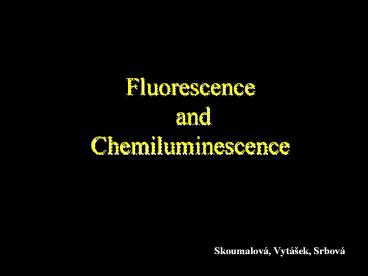Fluorescence and Chemiluminescence - PowerPoint PPT Presentation
Title:
Fluorescence and Chemiluminescence
Description:
... in the intensity of some fluorescent dye due to the quenching action of the measured sample Natural fluorophores Polyaromatic hydrocarbons Vitamin A, E ... – PowerPoint PPT presentation
Number of Views:442
Avg rating:3.0/5.0
Title: Fluorescence and Chemiluminescence
1
Fluorescence andChemiluminescence
- Skoumalová, Vytášek, Srbová
2
Luminescence
- Emission of radiation, which occurs during
returning of excitated molecules to ground state - Fluorescence, phosphorescence excitation is
caused by absorption of radiation - Chemiluminiscence excitation is caused by
chemical reaction
Singlet state - spins of two electrons are
paired Triplet state - spins of two electrons are
unpaired
3
Fluorescence and fosforescence
4
Energy level diagram for photoluminescent
molecules
- Radiationless transitions
- VR vibrational relaxation
- IC- internal conversion
- ISC intersystem crossing
Radiation transitions Fluorescence - transition
to the ground state with the same multiplicity
S1?S0 probability of fluorescence is higher
than phosphorescence Phosphorescence transition
between states with different multiplicity T1?S0
5
Stokes shift
Wavelength difference between absorption
(excitation) and fluorescence (emission) maximum
- Wavelength of emitted radiation is longer because
its energy is lower - E h . c/?
http//psych.lf1.cuni.cz/fluorescence/soubory/prin
cipy.htm
6
Quantitative fluorescent measurement
Fluorescence efficiency (?f ) is the fraction of
the incident radiation which is emitted as
fluorescence ?f lt 1
7
Fluorescence measurement
Filter fluorimeters Spectrofluorometers
Fluorescent microscopes Fluorescent scanners
Flow cytometry
8
Spectrofluorometer
9
Spectrofluorometer
10
Analysis of the unknown sample
Erythrocytes (patients with Alzheimers disease)
11
Fluorescence microscopy
Endothelial cell (mitochondria, cytoskeleton,
nucleus)
12
Sources of interference
- Inner filter effect
- intensity of excitation light isnt constant
because each layer of the sample absorbs some of
the incident radiation (intensity of exciting
light is higher in the front part of cuvette and
lower in the rear part of cuvette - Quenching
- excited molecule returns to the ground state by
radiationless transition (without emitting light)
as a result of a collision with quenching
molecule - Quenching agents O2, halogens (Br, I),
nitrocompounds
13
Methods of fluorescence determination
- Direct methods - natural fluorescence of the
fluorecent sample is measured - Indirect (derivatisation) methods - the
nonfluorescent compound is converted into a
fluorescent derivative by specific reaction or
marked with fluorescent dye by attaching dye to
the studied substance - Quenching methods - analytical signal is the
reduction in the intensity of some fluorescent
dye due to the quenching action of the measured
sample
14
Natural fluorophores
- Polyaromatic hydrocarbons
- Vitamin A, E
- Coenzymes (FAD, FMN, NADH)
- Carotenes
- Quinine
- Steroids
- Aromatic aminoacids
- Nucleotides
- Fluorescent proteins GFP (green fluorescent
protein)
15
Nobel prize in chemistry in 2008
- Osamu Shimomura discovered green fluorescent
protein (GFP) in the small glowing jellyfish
Aequorea victoria - Martin Chalfie introduced using of green
fluorescent protein as a marker for gene
expression - Roger Y. Tsien engineered different mutants of
GFP with new optical properties (increased
fluorescence, photostability and a shift of the
major excitation peak ) and contributed to the
explanation of mechanismus of GFP fluorescence
16
Fluorescent probes
- Compounds whose fluorescence doesnt change after
their interaction with biological material - acridine orange (DNA)
- fluorescein (proteins)
- rhodamine (proteins)
- GFP
- Compounds whose fluorescence change according to
their environment - ANS (1-anilinonaftalen-8- sulphonate) -
polarity - Fura-2 - tracking the movement of calcium within
cells
17
Some applications of fluorescence detection
- Protein conformation
- Membrane potential
- Membrane transport
- Membrane viscosity
- Enzymatic reactions
- DNA analysis
- Genetic engineering (manipulations)
- Immunochemical methods
- Cell proliferation and apoptosis
18
Chemiluminiscence
19
Chemiluminescence
- Excitation of electrons is caused by chemical
reaction - Return to ground state is accompanied by light
emission - Bioluminescence
luciferase
ATP luciferin O2
AMP PPi CO2 H2O oxyluciferin light
20
Application of chemiluminescence detection
- NO assay
- NO O3 ? NO2 O2
- NO2 ? NO2 light
- H2O2 assay, peroxidase activity assay,
immunochemical assays - Luminol H2O2
3-aminoftalate light
peroxidase
21
Summary 1. The principle of fluorescence 2.
Applications of fluorescence in medicine -
examples 3. Chemiluminescence - applications































